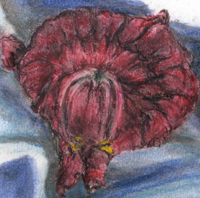| Charcoal in West Africa |
 |
| Mountains of charcoal confiscated from illegal charcoal laborers in Eastern Senegal |
| Issues and numbers in the economically-important charcaol industry |
| LINK TO TABLES AND DETAILS ON CONVERSION FACTORS AND STATISTICS go there ASSOCIATED WITH CHARCOAL VOLUMES, GROWTH, TRANSPORT, AND ECONOMICS IN WEST AFRICA |
| A unit of volume used to describe charcoal for transport is a "quintaux". A quintaux is supposed to equal 100 kg of charcoal; it traditionally was accounted as the volume to fill two 50-kg grain bags for the convenience of transporters, foresters, and laborers. (See link to document with table of conversions.) Changing the real volume in the sacks by over-stuffing them and attaching height extensions allows for favors to be granted to actors in the market chain, or makes the sacks more attractive to potential buyers. |
| In general, it is more efficient to transport lighter-weight charcoal over long distances than green or dry firewood. With a 28% thermal energy, the value of charcoal equals the price of its transport by an old inefficient truck at a distance of 1000 km (Keita, J.D. document). Green wood contains 280 Kcal of useable energy per kg, and charcoal contains 420 Kcal. |
| SOME FACTS ABOUT CHARCOAL |
| Lady Forester Home Page -> |
 |
 |
| Traditional charcoal production involves stacking and burning wood (almost 30 tonnes of green wood) in huge piles ("kilns") that produce a truckload at a time (300 sacks or 150 quintaux). In principle, an improved-efficiency "Casamance kiln" (which requires wood to be stacked in a precise configuration and uses a welded-barrel chimney that produces creosote as a marketable by-product) can almost double the usable energy available in the same volume of wood. |
| Dakar, with its several millions in population and a competing bottled gas market for cooking, required 300,000 tonnes of charcoal in 2005. This was the equivalent of 3 million quintaux or about 20,000 truckloads. In 2008, the cost of a kg of charcoal to the home user is 125 fCFA ($0.30). This makes the "street value" of each tonne equal to $US 300. |
| Species preferred for producing charcoal are those which produce less smoke and sparks. In West Africa, this usually means members of the Combretum family: C. glutinosum, C. nigricans, C. micranthum, and Guiera senegalensis especially. These are usually multi-stemmed, will produce good charcoal when 10 or more cm in diameter, and will regenerate to their original size after 6 to 20 years depending on protection and rainfall. In places where other species are more abundant, other hard and dense species are used, such as Pterocarpus. |
 |
 |
 |
 |
 |
 |
 |
| Rings say this tree was about 14 years old when it was cut. |
| Within 2 years, this Combretum glutinosum has re-sprouted from the stump in multiple stems that could be thinned to favor 3 of them to grow faster |